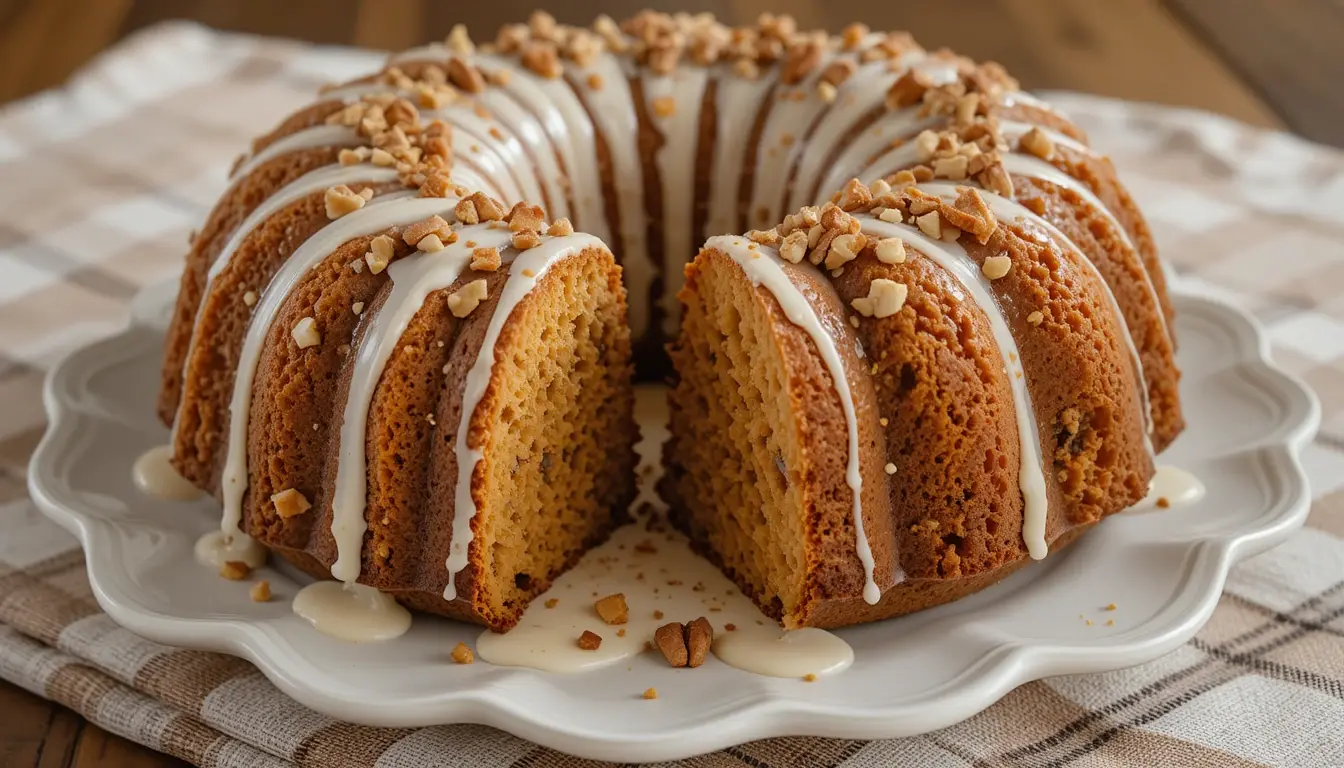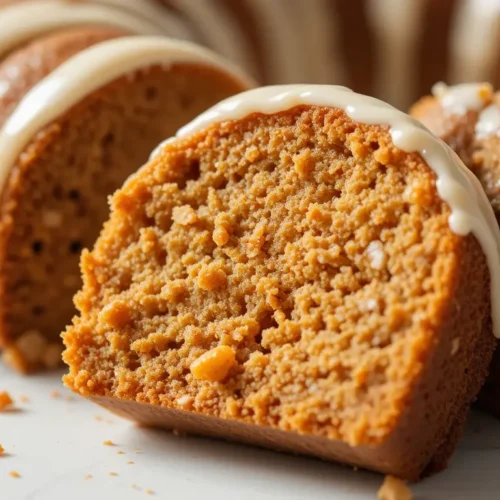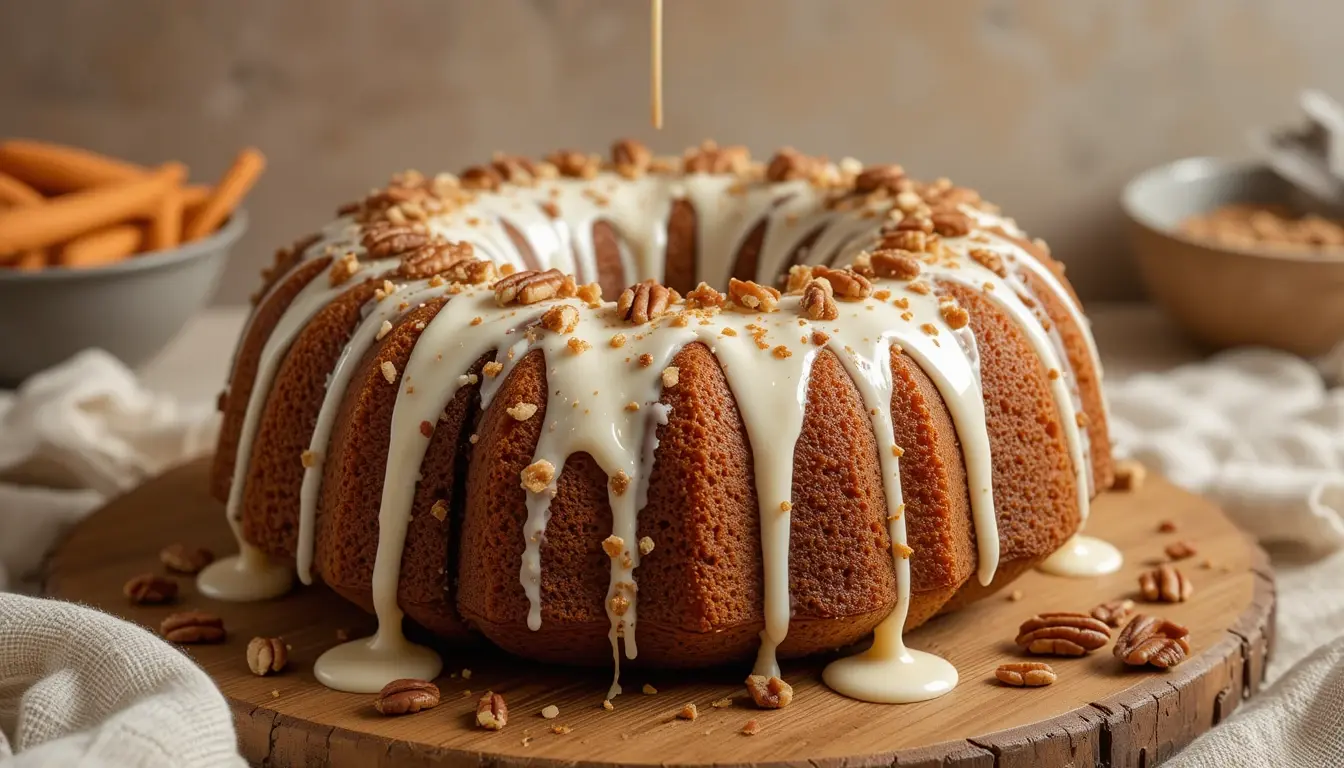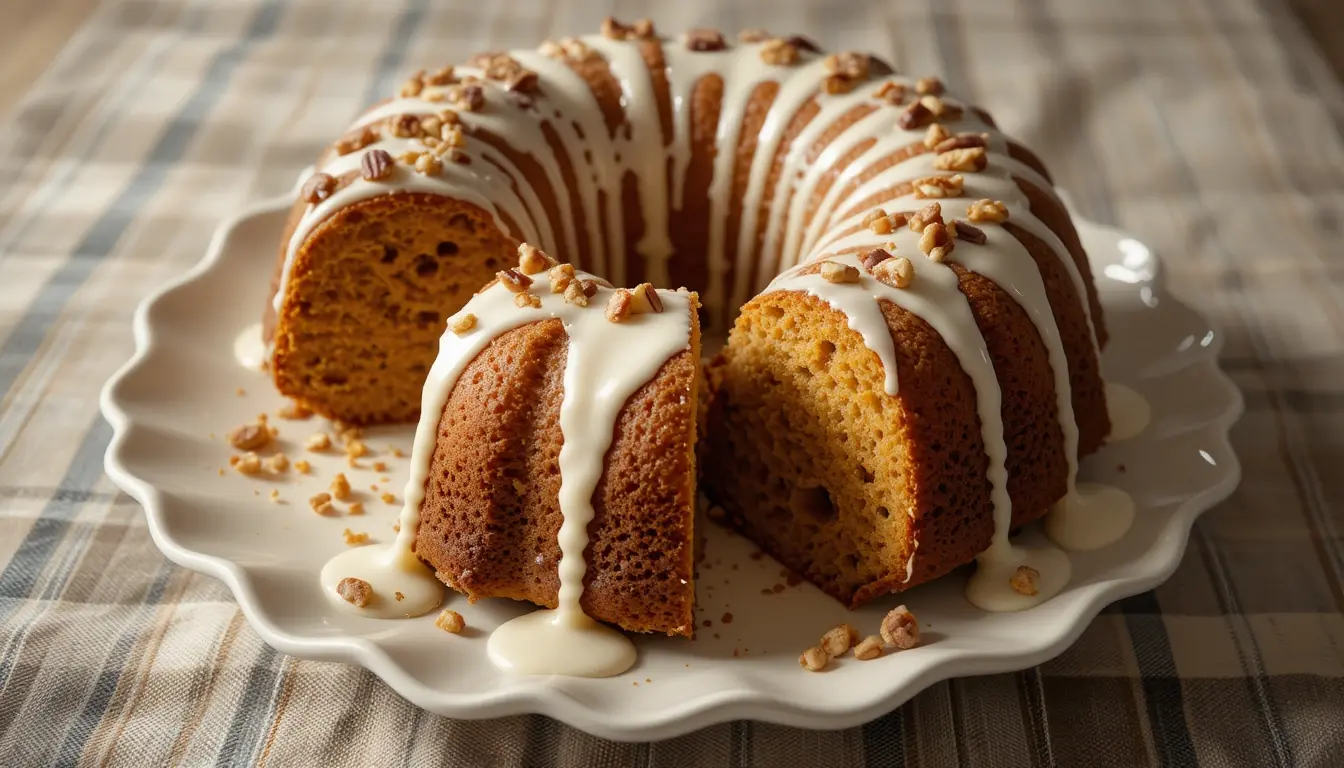When you think of a classic cake that checks every box comforting, lightly spiced, perfectly moist it’s hard to beat a carrot bundt cake. From the sculpted edges that catch the glaze to the hearty richness of carrots, nuts, and warm spices, this dessert feels both timeless and joyfully rustic. In this article, we’ll walk through everything: the story behind this cake, how to bake it right, why the bundt shape matters, and how to make that silky cream cheese glaze that makes people linger just a little longer at the table.
Table of Contents
Carrot Bundt Cake Recipe
A Southern-Inspired Cake That Feels Like Home
How My Midwest Roots and Blue Ridge Living Shape This Recipe
Carrot bundt cake is more than a dessert to me it’s a slice of my story. Growing up in a small Midwestern town, we baked with purpose. My grandma’s carrot cake always made an appearance at church potlucks, filled with shredded carrots and a whisper of spice. But it wasn’t until I moved to the foothills outside Asheville that I truly fell in love with bundt-style baking.
Here in the Blue Ridge, the seasons speak through ingredients. Spring carrots from the tailgate market, local yogurt, and sometimes pecans gathered from a neighbor’s tree make their way into my version. I test this cake every time with the same intention: to create something that feels grounded and generous.
Whether you’re baking for Easter brunch, a holiday table, or just a Tuesday sweet tooth, this carrot bundt cake delivers warmth and texture in every forkful. The bundt shape isn’t just about looks it encourages even baking and adds just enough crust to frame the soft center. Plus, it makes for a showstopper when drizzled with cream cheese glaze.
I’ve always believed food tells stories. This cake carries memories of layered casseroles, church basements, and now my mountain-side kitchen. It holds together my past and present, and I hope it finds a place in your recipe box too.
If you love cakes with heart and flavor, you’ll probably enjoy these carrot cake cookies or these playful mini cupcakes that I use for holiday trays.

What Makes a Bundt Cake Special?
The History and Function of Bundt Pans
Bundt cakes, like this unforgettable carrot bundt cake, owe part of their charm to the pan that shapes them. The bundt pan has roots in Europe, where similar molds were used for dense yeasted cakes. In America, the design became iconic when Nordic Ware trademarked the name “Bundt” in the 1950s. The fluted sides and central hole allow even baking and a beautiful crust, making your cake look impressive without needing layers or fancy decorations.
Unlike traditional cake pans, the bundt design supports a moist, rich batter ideal for ingredients like shredded carrots, pineapple, and nuts. That’s why a carrot cake baked in bundt form feels even more decadent. The ridges hold onto glaze or icing, offering a perfect balance of crunch and softness in every bite.
This style also makes serving easy. A good carrot bundt cake slices clean, holds its shape, and creates instant table appeal. I’ve even adapted this style for my mini cupcakes when I want individual portions that echo the bundt form.
How Texture and Shape Change in a Bundt Format
When you bake carrot cake in a bundt pan, you’re doing more than just changing its shape. You’re enhancing the texture. The hole in the middle creates more surface area, helping the cake bake evenly, stay moist, and avoid the dreaded soggy center.
The outer edges of a carrot bundt cake caramelize slightly, giving you that golden crust that contrasts beautifully with the soft interior. This is especially noticeable when using brown sugar, pineapple, and yogurt in the batter. You get deep flavor notes and a denser crumb that’s more satisfying than a standard round or sheet cake.
It’s why bundt cakes work beautifully for rustic recipes like this one or even modern spins like this gluten-free cupcake recipe that I’ve developed for allergen-friendly celebrations.
Carrot bundt cake isn’t just pretty, it’s practical. The design helps avoid common issues like sinking centers or uneven rise. And best of all, it looks like a centerpiece without needing extra effort.

Carrot Bundt Cake Recipe
Ingredients
Carrot Bundt Cake:
- 2 cups 225 g finely grated carrots (about 3 medium carrots)
- 1 cup 190 g canned pineapple, blended and drained (use pineapple in juice)
- 2¼ cups 290 g all-purpose flour
- ¼ cup 30 g cornstarch
- 2 tsp baking powder
- ½ tsp baking soda
- ½ tsp salt
- 2½ tsp ground cinnamon
- 1¾ tsp ground ginger
- ¼ tsp ground cloves
- ½ tsp ground nutmeg
- 1½ cups 300 g soft brown sugar, packed
- 3 large eggs room temperature
- 1 cup 200 g unflavored vegetable oil (canola preferred)
- 3 tsp vanilla extract
- ½ cup 110 g plain yogurt (regular or low-fat Greek), room temperature
- 1 cup 100 g chopped pecans or walnuts (or a mix)
Cream Cheese Glaze:
- 2 cups 240 g powdered sugar
- 2 tsp unsalted butter melted
- ½ tsp vanilla extract
- ¾ cup 170 g cream cheese, room temperature
Instructions
Carrot Bundt Cake:
- Set your oven rack in the lower third of the oven and preheat oven to 180°C (350°F) conventional (see note 3 if using a convection oven with a fan). Very generously grease and flour a 12-cup bundt pan, or use a baking spray or cake release that has flour in it (I use my homemade cake release to grease my pan). Set aside for now.
- Start by peeling and finely grating the carrots, then set them aside. Next, prepare the pineapple—drain the liquid from the canned pineapple, blend it, and set it aside.
- In a bowl, sift together your flour, cornstarch, baking powder, baking soda, salt, cinnamon, ginger, cloves, and nutmeg. Using a whisk, mix until well combined. Set aside.
- In a large mixing bowl combine your soft brown sugar, eggs, vegetable oil, vanilla, yoghurt and crushed pineapple. Using a whisk, mix until well combined, and then for a further minute to incorporate some air into the batter.
- Add your dry ingredients into your wet mixture and using a spatula, gently fold together until just combined. Do not overmix.
- Add in the grated carrots and walnuts and/or pecans. Using a spatula, gently fold through until just combined. Do not overmix.
- Pour the batter into the prepared bundt pan, smoothing the top as best you can. Give the pan a little shake to help the batter settle into all the corners, then tap it lightly on the counter twice to release any large air bubbles. Bake for 45-50 minutes, or until a skewer inserted into the thickest part of the cake comes out clean or with a few moist crumbs.
- Once ready, allow the cake to cool in the cake tin for 45 minutes, before turning it out onto a wire rack to finish cooling (see note 4 if your bundt cake doesn’t come out).
Cream Cheese Glaze
- In a medium bowl, combine powdered sugar, butter, vanilla and cream cheese. Using a hand or stand mixer on a low speed, mix until well combined and smooth. The glaze should be thick in consistency.
- Once the bundt cake is completely cool, pour the glaze evenly over the top of the cake. Slice and enjoy!
Notes
Even after draining the canned pineapple, the blended result should still be somewhat liquid. If it’s too thick, stir in a small splash of the reserved pineapple juice or a bit of water until it loosens slightly. 2. Brown Sugar Measuring Tip
If you’re using measuring cups, firmly pack the soft brown sugar. Fill the cup, press it down gently with the back of a spoon, then top it off if needed to ensure a full, compact measure. 3. Baking with a Convection Oven
If your oven uses a fan (convection setting), lower the baking temperature to 160°C (320°F), as the fan circulates heat more quickly and evenly. 4. Releasing the Cake from the Pan
After the cake cools, it should come out easily with a gentle shake. If it sticks, lightly run a knife around the inner and outer edges. You can also place a warm, damp cloth over the bundt pan to help loosen any stubborn spots.
Nutrition Information (Per Serving)
| Nutrient | Amount |
|---|---|
| Calories | 494 kcal |
| Carbohydrates | 58 g |
| Protein | 6 g |
| Fat | 28 g |
| Saturated Fat | 5 g |
| Polyunsaturated Fat | 13 g |
| Monounsaturated Fat | 9 g |
| Trans Fat | 0.2 g |
| Cholesterol | 51 mg |
| Sodium | 296 mg |
| Potassium | 231 mg |
| Fiber | 2 g |
| Sugar | 54 g |
| Vitamin A | 3883 IU |
| Vitamin C | 3 mg |
| Calcium | 116 mg |
| Iron | 1 mg |
Ingredient Deep Dive & Tips for the Best Carrot Bundt Cake
Why Pineapple, Yogurt, and Brown Sugar Make This Cake Unforgettable
The secret to a perfect carrot bundt cake lies in the balance of moisture, texture, and spice. And it all starts with the ingredients.
Let’s talk pineapple. Blended canned pineapple, drained well before mixing, brings a natural sweetness and a gentle tang that cuts through the richness. It also keeps the cake soft without making it wet. I always use pineapple in juice, never syrup, for a cleaner flavor.
Next is yogurt. In this recipe, plain unsweetened yogurt adds body and structure. It reacts with the baking soda for a little lift, but more importantly, it gives that soft, almost creamy crumb every good bundt cake should have. You can use low-fat Greek yogurt in a pinch, though I recommend regular for a richer result.
Brown sugar, particularly soft and packed, brings molasses undertones that tie the spices together. Unlike white sugar, brown sugar retains moisture during baking, which is key when working with drier mix-ins like grated carrots.
Together, these ingredients turn a standard batter into something lush, aromatic, and incredibly satisfying. It’s why I return to this recipe over and over again just like I do with Oreo mug cake when I need something fast but comforting.
How to Choose Between Walnuts and Pecans, and Why It Matters
One question I get all the time is: should I use walnuts or pecans in carrot bundt cake? The truth is, you can’t go wrong with either but they do offer different things.
Walnuts have a slightly bitter edge and a firmer bite. They’re great for contrast, especially if you like that crunchy, rustic feel. Pecans, on the other hand, are buttery, slightly sweet, and soften more during baking. They melt into the crumb and give a warmer flavor profile.
I usually do half and half ½ cup pecans, ½ cup walnuts to get the best of both worlds. But if you’re baking for someone who prefers one over the other, go all in. Just make sure your nuts are coarsely chopped, not finely ground. You want texture, not flour.
This mix-in moment is also when you could get creative. For a festive twist, a handful of shredded coconut or a sprinkle of orange zest in the batter would pair beautifully with the spice and pineapple.
And while you’re thinking of variations, this same spiced spirit works wonderfully in carrot cake cookies a chewy, snackable version I often bake alongside the bundt for gifting or freezing.
Using quality ingredients in the right ratios ensures your carrot bundt cake comes out moist but not heavy, spiced but not overpowering, and rich without being cloying. Every bite tells a story of balance, and that’s what makes this recipe shine.
Glazing, Serving & Storage Tips for Carrot Bundt Cake Recipe
The Cream Cheese Glaze That Brings It All Together
A great carrot bundt cake deserves a glaze that does more than just sit pretty and this cream cheese glaze does exactly that. It’s tangy, velvety, and sweet without being overpowering.
What makes this glaze different is the balance. It starts with room-temperature cream cheese blended with powdered sugar and a touch of melted butter. This combination ensures it stays thick, rich, and pourable, rather than runny. A hint of vanilla gives it warmth, echoing the spices in the cake itself.
When applying the glaze, wait until the carrot bundt cake is completely cool. If you pour too soon, the glaze will slide right off. I like to use a spoon or piping bag to create thick drips that cling to the edges of the bundt’s ridges. It’s visually stunning and adds that irresistible finish that makes guests ask for seconds.
Want a seasonal spin? You can stir in a bit of maple syrup or orange zest for a glaze that feels extra festive. I’ve done this for holiday brunches alongside batches of gluten-free cupcakes and it always gets rave reviews.
Serving, Slicing, and Storing for Best Flavor and Texture
Once your carrot bundt cake is glazed and set, you’re ready to serve. Use a serrated knife to gently slice through the ridges, letting the crusty exterior give way to the moist center. This cake holds its shape well, which makes it perfect for entertaining or slicing ahead of time.
Serve it slightly chilled for firmer slices, or at room temperature if you want a softer texture and bolder flavor. I often serve mine on a rustic wood board with a few candied walnuts or edible flowers for color.
For storage, wrap the cake tightly in plastic wrap or store it in an airtight container. It stays fresh for up to 4 days at room temperature or up to a week in the fridge. You can also freeze it either whole or in slices. Just thaw at room temp and glaze fresh before serving if freezing unglazed.
Leftover slices make a dreamy breakfast with coffee, and this recipe works beautifully as a prep-ahead dessert for busy weeks. It’s the kind of cake that only gets better by day two, as the spices mingle and settle into the crumb.
And if you’re a fan of make-ahead sweets, you’ll love how easy it is to adapt this method for other recipes on the site, like pancake sausage casserole for brunch or oreo mug cake when you’re craving something quick.
Whether you’re making it for a gathering or a quiet afternoon slice, this carrot bundt cake delivers bold flavor, cozy spice, and perfect texture all wrapped up in a gorgeous glazed finish.

Conclusion
Carrot bundt cake is more than a sweet treat. It’s a timeless blend of spice, texture, and heart. From the finely grated carrots to the tangy cream cheese glaze, every ingredient has a purpose and every bite tells a story.
Whether you’re baking it for a holiday table, a cozy weekend, or a loved one’s birthday, this recipe brings something special. It’s the kind of cake that feels familiar yet celebratory. It’s rugged enough for casual dinners, yet elegant enough to sit at the center of a feast.
I’ve made this carrot bundt cake more times than I can count. Every time, it reminds me why I love baking because good food connects us. It invites people in. It sparks conversation. It creates memory.
If you’re ready to bake something that’s simple, soulful, and stunningly good, this carrot bundt cake is your new go-to. Let it be the cake that brings people to the table and keeps them lingering just a little longer.
For more recipes follow me in Facebook
Frequently Asked Questions About Carrot Bundt Cake
Does Nothing Bundt Cake carrot cake have nuts?
Yes, the carrot cake from Nothing Bundt Cake typically contains walnuts. This adds a bit of crunch and depth to the moist, spiced crumb. If you’re baking at home and want a similar texture, you can use walnuts, pecans, or a mix of both in your carrot bundt cake.
Can I make carrot cake in a bundt pan?
Absolutely! A bundt pan is perfect for carrot cake. The shape allows for even baking, and the ridges help capture glazes or frostings beautifully. A carrot bundt cake made this way often has a firmer crust and a soft, tender center, making it ideal for both presentation and texture.
What does Bundt mean in cake?
“Bundt” refers to the type of pan, not a specific recipe. Bundt pans have a distinctive ring shape with fluted sides and a center tube. This design allows cakes like carrot bundt cake to bake evenly and look elegant straight out of the pan no fancy decorating required.
What makes Bundt cakes special?
Bundt cakes are beloved for their unique shape and ability to hold moisture while baking. The pan’s design creates more crust surface and helps the center cook evenly. For a rich and spiced dessert like carrot bundt cake, this means better texture, flavor distribution, and a stunning presentation every time.

